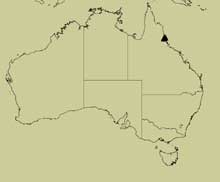Synonyms
Scymnomorphus ker Slipinski and Tomaszewska, 2005: 383.
Diagnosis
This species is quite similar to S. storeyi but easily recognized by its dorsal setae being shorter and apparently denser, and the epipleural carina along the edge of elytron distinctly separated from the elytral margin.
Description
Length 1.1-1.2 mm. Winged; form oval, convex; dorsal surfaces densely setose with most of the setae short, suberect and pointing in various directions. Blackish or dark brown, head and pronotum lighter, usually deep brown, ventral side deeply brown to almost black; clypeus, labrum and appendages yellowish. Surfaces between punctures highly polished and strongly shiny. Head flat, regularly punctate, punctures irregular, each about as large as an eye facet, and bearing a short curved seta. Clypeus prominent, weakly arcuate anteriorly. Eyes large, coarsely facetted, dorsally separated by about twice width of an eye. Antenna 10-segmented with narrow 2-segmented club. Pronotum widest at base and distinctly narrowing anteriorly; pronotal margins very narrow and hardly visible from above; anterolateral line distinct, very close to anterior angle and clearly joining lateral margin. Disc convex, finely and irregularly punctate, punctures as large as those on frons, 2-4 diameters apart. Scutellum triangular, large, glabrous. Elytron shiny, coarsely punctate, punctures dual and appear to be in regular rows near suture but becoming distinctly irregular laterally; large punctures in rows and bearing long and erect setae, smaller punctures along intervals less regular and bearing short and more inclined setae.. Elytral margins narrow, visible from above at basal 2/3. Lateral part with epipleural carina separated from margin, forming thickened border and extending to level of abdominal ventrite 3. Abdomen: postcoxal line of first ventrite complete to lateral margin of ventrite; postcoxal disc smooth inside.
Male
Male genitalia: tegmen 1.2 times and median lobe 1-1.2 times as long as abdomen; trabes about 1.3 times as long as basal piece; parameres strongly reduced, each with single moderately long seta at apex.
Female
Not externally different from male.
Variation
Not observed.
 Distribution and Biology
Distribution and Biology
Known from few localites in northern Queensland, mostly from the Bellenden Ker Massif range. Adults have been collected in flight intercept traps. The larva is unknown. Click on map for larger version (use the bowser 'back arrow' to return to this page).
Species References
Slipinski, A, Tomaszewska, W. 2005. Revision of the Australian Coccinellidae (Coleoptera). Part 3. Tribe Sukunahikonini. Australian Journal of Entomology, 44: 369-384.
[ Top ]
